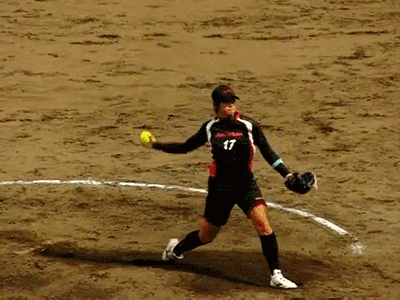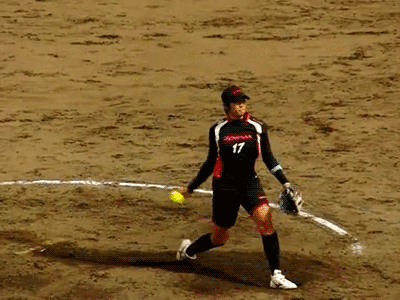How Should Your Fastball Spin?
If this isn’t the number one question we receive via email and comments, it’s definitely at least in the top three. However, it’s not the question you should be asking. What you want to know is: how much should you CARE how your fastball is spinning?
There’s a lot of conflicting information about this out there, and I really want to simplify the information and focus your concerns today. The truth is, there is no single correct answer, but there are different areas that the pitcher should focus on depending on her level.
The basics: 4-seam rotation? Bullet spin?
We always start beginner pitchers with a basic C-grip, so for this portion we are not going to discuss alternate grips, such as a 2-seam grip, a cut fastball grip, etc. that are intended to produce different effects. We are talking about a basic grip and a basic forearm fire fastball.
Here’s our favorite example, Yukiko Ueno, warming up:

We have shown this example many times because it is such excellent forearm fire. Her arm is so loose and rubbery, the ball is facing up in back, and then her hand flops over (internally pronates) in relaxation as she finishes (watch the video for a much better sense of her relaxation)
Below, however, notice the snap itself:

This is forward snap! It’s the same snap direction that you’d get if you forced your wrist snap and finished elbow to the catcher, but Ueno’s is much faster because hers is UNFORCED.
So…her ball was facing the sky at the beginning of the throw zone, and her hand turned over the completely opposite way at the end of the throw zone, yet her actual snap was forward. How does that work? If the wrist is truly relaxed, it moves naturally and independently. Think of the entire arm as a whip, and the wrist as the very tip of the whip, the last little sting.
The takeaway: is 4-seam rotation possible with forearm fire? YES.
Does every great pitcher throw with 4-seam rotation? NO. Absolutely not. In fact, I doubt even Ueno does in games; she’s just warming up.
Do YOU have to? NOPE.
Now, a breakdown of what’s important…
Beginner-intermediate pitchers
For those of you either just learning or working on perfecting forearm fire, the important thing is just that: forearm fire. Worry about the feeling of the whip, NOT the direction of the spin.
If your arm is as relaxed and as fast as humanly possible, which of course is everyone’s goal, natural forward snap and 4-seam rotation should theoretically be possible.
However, REALISTICALLY, you’re not going to have Ueno’s whip while you’re learning. Chances are even if you have pretty good whip, your wrist may not be fast enough to snap forward. This will result in bullet spin, or something close to it.
THIS IS OKAY.
If you balance your pitch with great posture and great leg drive, you can throw pretty darn fast with bullet spin, or something in between bullet and 4-seam spin. In fact, according to physics, 4-seam spin may be marginally the fastest, but it also flies the straightest with the least movement. You might not even want that!
The takeaway: if you’re learning forearm fire, do not worry about the direction of your spin.
What SHOULD concern you is the amount of spin. If you ball is floating and spinning very little, chances are your arm is quite stiff and you’re not getting much whip at all. Relax, whip, and get as much spin on the ball as you can without concerning yourself with the particulars of that spin.
Advanced pitchers
You’ve hit your speed goal through perfecting your mechanics, and you’re seeking those last few MPH through strength training. You should not be worried about how your fastball is spinning either! You should be…
- Working on multiple spins for multiple pitches
- Threading a needle with your fastball to set up your other pitches and act as a safety net when you’re behind in the count
- Maybe playing with alternate grips to achieve different effects with your fastballs
In short, in the basic game there are more important things to worry about. In the advanced game, you need to change pitches and speeds so often to keep batters off balance that no one is going to measure the precise rotation of your fastball. And as long as you have great arm whip and great drive + front side resistance, you’ll get plenty of speed on your pitch.
Hello, my daughter is 9 and has learned plenty from your site, so thanks for that. However, not sure what the problem is, but half her pitching tend to move to the right (she is a right handed pitcher) much like a cut fastball would in baseball. Not sure is she isn’t following through, not relaxed enough, weal wrist action. Everything else looks good, and pretty good results with the exception of those pitches. She says that she throws those the same way she throws the other pitches that don’t cut. Hope you have time to provide some feedback, and thank you in advance. Devoted father of softball. Gus.
Hi Gus,
She’s probably moving her right hip toward the catcher a little faster than her arm. At age 9, chances are her whip relaxation has a long way to go too, and this is normal. It’s hard to get true wrist relaxation with a small hand.
“What SHOULD concern you is the amount of spin. If you ball is floating and spinning very little, chances are your arm is quite stiff and you’re not getting much whip at all. ”
This is a quote from your article about fastball spins .
My teachings, experience and comments about lack of spin are in the context of growth as a pitcher. Younger pitchers ( 8 years through 13 years old ) are a product of having mostly small hands and fingers. At those ages they tends to grip the ball deep in their hand and push it with the callouses where their fingers and hand connect. This does not generate maximum spins when thrown. As a pitcher gets older I have them play overhand catch with baseballs to develop the feeling of using their fingertips and wrists. This translates very well to pitching softballs once they get the ball out on the fingertips to throw. When they start to do this the increased spin when pitching is a dramatic improvement…..
Have you ever had pitchers throw baseballs overhand to increase the spins when pitching softballs?
P.S. Throwing baseballs overhand is a great tool to increase an overhand softball throw velocity….
Hi Fred, thanks for your comment. Your observations are certainly right; palming the ball due to small hands is a big factor in lack of spin. In fact the tension caused by palming the ball often works its way up the whole arm and stifles the entire whip process.
We do encourage throwing baseballs! It’s a wonderful tool. I discussed it in depth here: https://www.fastpitchpower.com/young-softball-girls-throwing-baseball/